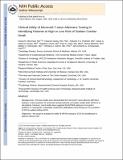Clinical utility of microvolt T-wave alternans testing in identifying patients at high or low risk of sudden cardiac death
Author(s)
Merchant, Faisal M.; Ikeda, Takanori; Pedretti, Roberto F.E.; Salerno-Uriarte, Jorge A.; Chow, Theodore; Chan, Paul S.; Bartone, Cheryl; Hohnloser, Stefan H.; Cohen, Richard J.; Armoundas, Antonis A.; ... Show more Show less
DownloadCohen_Clinical utility.pdf (773.5Kb)
PUBLISHER_CC
Publisher with Creative Commons License
Creative Commons Attribution
Terms of use
Metadata
Show full item recordAbstract
Background
Previous studies have demonstrated that microvolt T-wave alternans (MTWA) testing is a robust predictor of ventricular tachyarrhythmias and sudden cardiac death (SCD) in at-risk patients. However, recent studies have suggested that MTWA testing is not as good a predictor of “appropriate” implantable cardioverter-defibrillator (ICD) therapy as it is a predictor of SCD in patients without ICDs.
Objective
To evaluate the utility of MTWA testing for SCD risk stratification in patients without ICDs.
Methods
Patient-level data were obtained from 5 prospective studies of MTWA testing in patients with no history of ventricular arrhythmia or SCD. In these studies, ICDs were implanted in only a minority of patients and patients with ICDs were excluded from the analysis. We conducted a pooled analysis and examined the 2-year risk for SCD based on the MTWA test result.
Results
The pooled cohort included 2883 patients. MTWA testing was positive in 856 (30%), negative in 1627 (56%), and indeterminate in 400 (14%) patients. Among patients with a left ventricular ejection fraction (LVEF) of ≤35%, annual SCD event rates were 4.0%, 0.9%, and 4.6% among groups with MTWA positive, negative, and indeterminate test results. The SCD rate was significantly lower among patients with a negative MTWA test result than in patients with either positive or indeterminate MTWA test results (P <.001 for both comparisons). In patients with an LVEF of >35%, annual SCD event rates were 3.0%, 0.3%, and 0.3% among the groups with MTWA positive, negative, and indeterminate test results. The SCD rate associated with a positive MTWA test result was significantly higher than that associated with either negative (P <.001) or indeterminate MTWA test results (P = .003).
Conclusions
In patients without ICDs, MTWA testing is a powerful predictor of SCD. Among patients with an LVEF of ≤35%, a negative MTWA test result is associated with a low risk for SCD. Conversely, among patients with an LVEF of >35%, a positive MTWA test result identifies patients at significantly heightened SCD risk. These findings may have important implications for refining primary prevention ICD treatment algorithms.
Date issued
2012-03Department
Institute for Medical Engineering and Science; Harvard University--MIT Division of Health Sciences and TechnologyJournal
Heart Rhythm
Publisher
Elsevier
Citation
Merchant, Faisal M., Takanori Ikeda, Roberto F.E. Pedretti, Jorge A. Salerno-Uriarte, Theodore Chow, Paul S. Chan, Cheryl Bartone, Stefan H. Hohnloser, Richard J. Cohen, and Antonis A. Armoundas. “Clinical Utility of Microvolt T-Wave Alternans Testing in Identifying Patients at High or Low Risk of Sudden Cardiac Death.” Heart Rhythm 9, no. 8 (August 2012): 1256–1264.e2.
Version: Author's final manuscript
ISSN
15475271